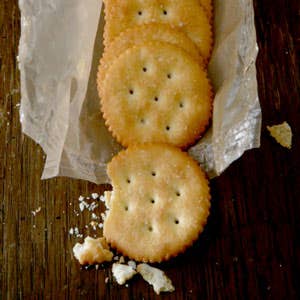
Putting on the Ritz
We combed the cracker aisle to figure out the mystery behind the mock apple pie.
Maybe we should have issued a disclaimer with the recipe for Mock Apple Pie: "No apples were harmed in the making of this dessert." But that would spoil the fun—and the illusion. Mock apple pie, also known as soda cracker pie and mystery torte, may consist of little more than crackers and lemony syrup baked in a pie crust, but it adds up to much more than the sum of its parts.
When I set out to make this pie, I assumed its persuasive texture and flavor were the invention of Nabisco's test kitchen. The company first issued a back-of-the-box recipe for it in 1935, a year after the introduction of the Ritz cracker. But, as it happened, thrifty cooks had long since discovered that crackers, when combined with cream of tartar, lemon juice, cinnamon, and sugar, bore an uncanny resemblance to apple filling. Civil War soldiers used their hardtack rations to simulate homemade apple pies, and even by that time the recipe was on its way west. As the food historian Barbara Haber told me, "We may never know who was the first person to substitute crackers for apples, but my money is on some lady in a poke bonnet in a covered wagon."
I hereby designate that lady, whoever she was, America's first molecular gastronomist. The basic recipe exhibits a remarkably intuitive understanding of the chemical properties of its ingredients. Adding cream of tartar—an acidic compound commonly used in cooking—helps crackers hold their shape and prevents the sugar syrup from crystallizing; it also breaks down the sucrose in the syrup into glucose and fructose, a sugar profile closer to that of apples. According to Paula Figoni, a former Pillsbury product developer who teaches food science courses at Johnson & Wales University, "Americans associate primarily cinnamon, secondarily lemon, with apple desserts." The combination tricks our brains into filling in the blank: where there's cinnamon and lemon, there must be apple.
Ben Mims, a SAVEUR test kitchen assistant, shared my fascination with the arcane properties of this pie. He made three versions: one with Ritz, one with soda crackers, and one with saltines. The Ritz crackers' high fat content made for a buttery, dense filling. The soda crackers held their shape for a convincingly striated and applesque effect. My favorite was the saltine version: the crackers' airy structure produced a wonderfully light result. Such preferences are highly subjective, though. Like this pie, born of homesickness and ingenuity, they say as much about emotion and imagination as they do about science.
Keep Reading
Continue to Next Story










